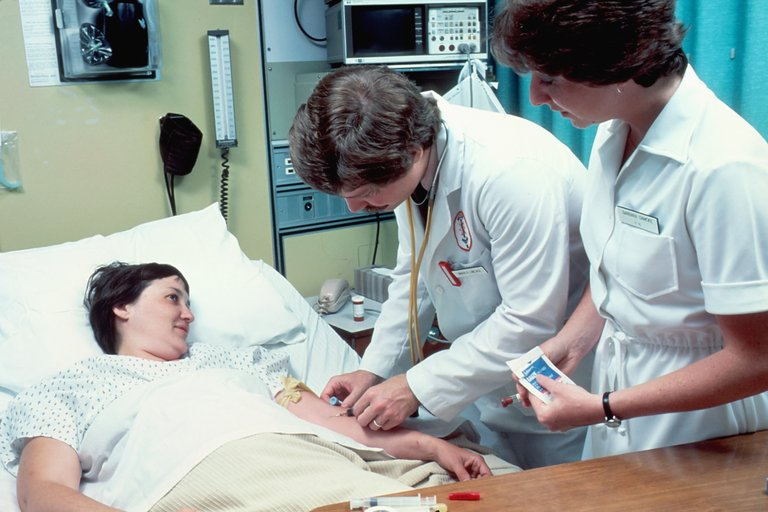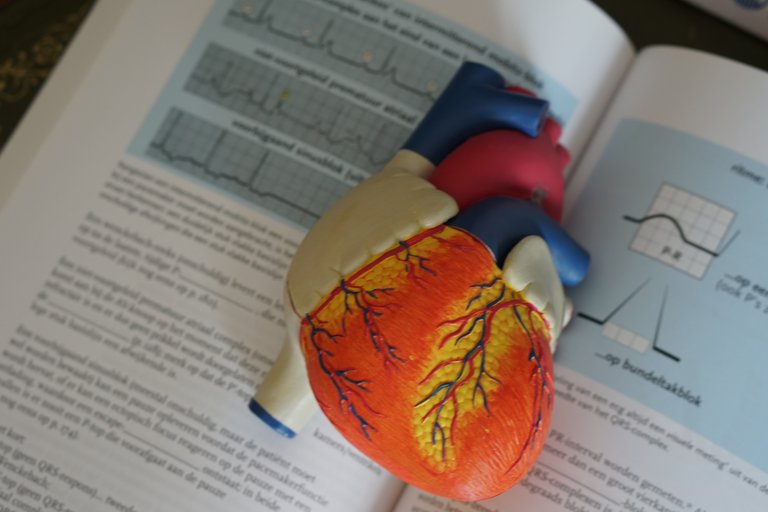[ES/EN] Hipertensión Arterial/Mis consideraciones

ESPAÑOL//ENGLISH
Hola amigos de #hive; el día de hoy les voy a hablar sobre una de las enfermedades de mayor incidencia y prevalencia a nivel mundial…la HTA (hipertensión arterial), según estadísticas de la OMS (organización mundial de la salud) millones de personas mueren anualmente por enfermedades crónicas no transmisibles (ECNT) y de ellas más de 17 millones es por enfermedades cardiovasculares, estrechamente relacionados con la HTA, razón que me motivó a hablarles sobre esta patología.
Hello friends #hive; the day of today, I'm going to talk about one of the diseases with the highest incidence and prevalence worldwide...HYPERTENSION (high blood pressure), according to statistics from the WHO (world health organization) million people die annually from chronic non-communicable diseases (ECNT), and of them, more than 17 million is due to cardiovascular disease, closely related to the HTA, the reason that motivated me to tell you about this pathology.
Cuando hablamos de ECNT nos referimos a toda enfermedad que su causa no es un agente biológico específicamente, en este caso es multicausal (factores de riesgo, predisposición genética, etc.), son de larga duración, de ahí que evolucionen hacia la cronicidad, provocando en ocasiones complicaciones y/o discapacidades, en este grupo solo pueden llegar a la cura (remisiones) el cáncer.
When we talk about NCDS we refer to any disease that its cause is not a biological agent specifically, in this case it is multicausal (risk factors, genetic predisposition, etc.), they are long-lasting, hence they evolve into chronicity, sometimes causing complications and / or disabilities, in this group they can only cure (remissions) cancer.
La HTA es una de las enfermedades más frecuentes en nuestro continente y nuestro país no está exento de ello. Entre sus múltiples causas la principal es la idiopática o esencial (80% según algunas bibliografías), aunque no esté demostrado que sea una enfermedad hereditaria como la Diabetes Mellitus, sabemos que en la práctica médica tiene similar comportamiento, pues vemos familias donde cada generación presenta dicha enfermedad, el resto de las causas son secundarias a otras patologías.
Hypertension is one of the most frequent diseases on our continent and our country is not exempt from it. Among its many causes, the main one is the idiopathic or essential (80% according to some bibliographies), although it is not proven that it is a hereditary disease such as Diabetes Mellitus, we know that in the medical practice has similar behavior, as we see families where each generation has the disease, other causes are secondary to other pathologies.
El mayor problema con estas enfermedades es que como tienen un período de latencia prolongado en ocasiones los pacientes desconocen que la padecen hasta que aparecen sus complicaciones o los síntomas logran llegar a ser más específicos, además que en ocasiones por la falta de estos creen que se curaron y abandonan los tratamientos.
The biggest problem with these diseases is that as they have a latency period prolonged at times the patients are unaware that they have it until they appear their complications or symptoms come to be more specific, in addition to at times by the lack of these believe that healed and abandon the treatment.

- Educarlos sobre cómo mantener un estilo de vida saludable.
- Diagnóstico temprano.
- Seguimiento adecuado.
- Evitar complicaciones.
- Rehabilitación física y psíquica del paciente enfermo.
- Educate them on how to maintain a healthy lifestyle.
- Early diagnosis.
- Proper follow-up.
- Avoid complications.
- Physical and psychological rehabilitation of the sick patient.
- Práctica de ejercicios diarios (30 min al menos 3 veces a la semana)
- Comer al menos 5 porciones de frutas y verduras al día.
- Consumir diversos tipos de fruta, verduras, legumbres (lentejas, frijoles, garbanzos, chícharos), frutos secos y cereales integrales (maíz, avena, arroz integral), tubérculos o raíces que contengan féculas (papa, ñame, malanga o yuca) y alimentos de origen animal (carne, pescado, huevos y leche).
- Consumir los vegetales preferentemente crudos.
- Evitar los alimentos fritos.
- Utilizar aceites saludables en la elaboración de los alimentos.
- Consumir menos de 1 cucharadita (50g) de sal al día.
- Evitar los alimentos procesados, embutidos, ahumados y enlatados.
- Reducir el consumo de azúcar.
- Daily exercise practice (30 min at least 3 times a week)
- Eat at least 5 servings of fruits and vegetables a day.
- Consume various types of fruit, vegetables, legumes (lentils, beans, chickpeas, peas), nuts and whole grains (corn, oats, brown rice), tubers or roots containing starches (potato, yam, malanga or yucca) and animal foods (meat, fish, eggs and milk).
- Consume vegetables preferably raw.
- Avoid fried foods.
- Use healthy oils in food preparation.
- Consume less than 1 teaspoon (50g) of salt per day.
- Avoid processed, cold cuts, smoked and canned foods.
- Reduce sugar consumption.
Para lograr un diagnóstico precoz y tratamiento oportuno debemos utilizar el método de diagnóstico por excelencia, la toma de la tensión arterial (TA). Esta puede llevarse a cabo usando 2 variedades de esfigmomanómetro:
El digital y el aneroide (el más conocido y usado en la comunidad médica).
Este proceder debe realizarse con la calidad necesaria o podrán obtenerse falsos resultados. La técnica a emplear es bastante similar en ambos equipos con algunas diferencias entre ellos.
- To achieve an early diagnosis and timely treatment we must use the diagnostic method par excellence, the blood pressure (BP). This can be carried out using 2 varieties of sphygmomanometer:
- The digitalis and the aneroid (the best known and used in the medical community).
- This procedure must be carried out with the necessary quality or false results may be obtained. The technique to be used is quite similar in both teams with some differences between them.

Primeramente, debemos conocer requerimientos básicos para efectuar dicho proceder:
El paciente no debe haber ingerido café, fumar ni realizar ejercicio físico 30 min antes de tomar la TA.
Debe estar en una habitación tranquila y con temperatura agradable.
Después procedemos a:
- Le comunicamos al paciente que no puede conversar.
- Debe apoyar el brazo a la altura del corazón.
- Colocar el brazalete del esfigmomanómetro en el brazo sin ropa.
- Usar el tamaño de brazalete adecuado.
- Apoyar los pies en el piso.
- No cruzar las piernas.
- Tener la vejiga vacía.
- Apoyar la espalda en la silla.
First, we must know basic requirements to carry out this procedure:
The patient should not have ingested coffee, smoked or performed physical exercise 30 min before taking the TA.
It must be in a quiet room with a comfortable temperature.
Then we proceed to:
- We communicate to the patient that he is unable to converse.
- You should rest your arm at the height of the heart.
- Place the sphygmomanometer cuff on the arm without clothing.
- Wear the appropriate bracelet size.
- Put your feet on the floor.
- Do not cross your legs.
- Having an empty bladder.
- Lean your back on the chair.
Al realizar estos pasos correctamente procedemos a chequear la presión arterial.
Según los valores obtenidos clasificaremos la presión arterial:
- -Normal
- -Prehipertensión
- -Hipertensión
Grado I
Grado II
Grado III - -Hipertensión sistólica aislada.
By performing these steps correctly we proceed to check the blood pressure.
According to the values obtained we will classify the blood pressure:
- -Normal
- -Prehypertension
- -Hypertension
Grade I
Grade II
Grade III - -Isolated systolic hypertension.
Una vez correctamente diagnosticado y clasificado el paciente se le indican todos los complementarios pertinentes para descartar patologías que pueden estar asociadas a esta enfermedad o complicaciones que puedan estar afectando al organismo. Estos pacientes deben atenderse nuevamente en consulta al menos 2 veces al año y 1 en terreno, de existir factores de riesgo agravantes que aumentarían sus probabilidades de complicaciones y/o secuelas, en esos casos el seguimiento sería según características de cada individuo.
El tratamiento se indicará según clasificación anterior y factores de riesgos concomitantes, estos se basarán en el uso principalmente de:
- Inhibidores de la enzima convertidora de angiotensiva (IECAS)
- Diuréticos
- Bloqueadores de los canales de calcio
- Estatinas
- Aspirinas
Once correctly diagnosed and classified the patient is indicated all the relevant complementary to rule out pathologies that may be associated with this disease or complications that may be affecting the body. These patients should be seen again in consultation at least 2 times a year and 1 in the field, if there are aggravating risk factors that would increase their chances of complications and / or sequelae, in those cases the follow-up would be according to the characteristics of each individual.
Treatment will be indicated according to previous classification and concomitant risk factors, these will be based on the use mainly of:
Angiotensin converting enzyme inhibitors (ACE inhibitors)
Diuretic
Calcium channel blockers
Statins
Aspirin
En ocasiones no podemos evitar que nuestros pacientes sufran complicaciones que posteriormente pueden dejar incapacidades como:
- Infarto agudo del miocardio.
- Accidentes vasculares encefálicos.
- Insuficiencia cardiaca.
- Retinopatía hipertensiva.
- Nefropatía hipertensiva.
- Insuficiencia renal crónica.
- Aneurismas.
Sometimes we cannot prevent our patients from suffering complications that can later leave disabilities such as:
- Acute myocardial infarction.
- Cerebral vascular accidents.
- Heart failure.
- Hypertensive retinopathy.
- Hypertensive nephropathy.
- Chronic renal failure.
- Aneurysms.
Pero lo que si podemos hacer es garantizar que estos pacientes sean rehabilitados física y psicológicamente para así lograr su reincorporación a la sociedad.
But what we can do is ensure that these patients are physically and psychologically rehabilitated in order to achieve their reintegration into society.
La HTA es la más común de las condiciones que afectan la salud de los individuos en el mundo, representa por sí misma una enfermedad, como también un factor de riesgo importante para otras enfermedades, de ahí la importancia de su control y disminución de incidencia a nivel mundial.
HYPERTENSION is the most common of the conditions that affect the health of individuals in the world, represents by itself a disease, as well as an important risk factor for other diseases, hence the importance of its control and reduction of incidence worldwide.

Bueno amigos hasta aquí mis criterios, consideraciones y apreciaciones personales como médico sobre la hipertensión arterial, espero que les guste y sea de su interés
Well friends so far my criteria, considerations and personal appreciations as a doctor about high blood pressure, I hope you like it and it will be of your interest.
Para la traducción se utilizó traductor de Google.
Google Translate was used for the translation.
Thanks for your contribution to the STEMsocial community. Feel free to join us on discord to get to know the rest of us!
Please consider delegating to the @stemsocial account (85% of the curation rewards are returned).
You may also include @stemsocial as a beneficiary of the rewards of this post to get a stronger support.